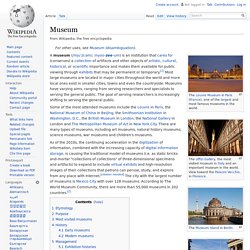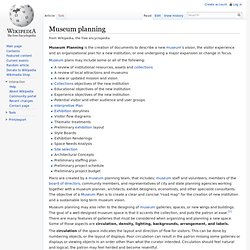

Portal:Ancient Egypt. Museum. Some of the most attended museums include the Louvre in Paris, the National Museum of China in Beijing, the Smithsonian Institution in Washington, D.C., the British Museum in London, the National Gallery in London and The Metropolitan Museum of Art in New York City.

There are many types of museums, including art museums, natural history museums, science museums, war museums and children's museums. As of the 2010s, the continuing acceleration in the digitization of information, combined with the increasing capacity of digital information storage, is causing the traditional model of museums (i.e. as static bricks-and-mortar "collections of collections" of three-dimensional specimens and artifacts) to expand to include virtual exhibits and high-resolution images of their collections that patrons can peruse, study, and explore from any place with Internet. [citation needed] The city with the largest number of museums is Mexico City with over 128 museums. Museum planning. Museum Planning is the creation of documents to describe a new museum’s vision, the visitor experience and an organizational plan for a new institution, or one undergoing a major expansion or change in focus.

Museum plans may include some or all of the following: Plans are created by a museum planning team, that includes; museum staff and volunteers, members of the board of directors, community members, and representatives of city and state planning agencies working together with a museum planner, architects, exhibit designers, economists, and other specialist consultants. The objective of a Museum Plan is to create a clear and concise “road map” for the creation of new institution and a sustainable long term museum vision. Museum planning may also refer to the designing of museum galleries, spaces, or new wings and buildings.
The circulation of the space indicates the layout and direction of flow for visitors. Interpretive planning. Interpretive planning is an initial step in the planning and design process for informal learning-based institutions like museums, zoos, science centers, nature centers, botanical gardens, heritage sites, parks and other cultural facilities where interpretation is used to communicate messages, stories, information and experiences.

It is a decision-making process that blends management needs and resource considerations with visitor needs and desires to determine the most effective way to communicate a message to a targeted audience.[1] Interpretation at informal learning institutions builds on Freeman Tilden’s principles of interpretation, focusing especially on relating content in a meaningful way to a visitor’s own experience, provoking emotion, thought or further inquiry into a subject. Why do you want to interpret something?